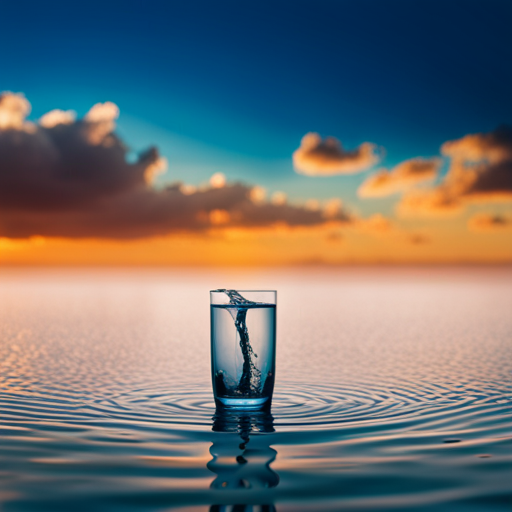Do you ever stop to think about the water you drink? It’s a basic necessity for life, but what if I told you that the water you’re consuming may contain microplastics – tiny pieces of plastic that could be harmful to your health? Unfortunately, it’s true.
In recent years, microplastics have become a growing concern, as they’re present in our air, tap water, and soil. These minuscule pieces of plastic, usually under 5mm in size, are virtually everywhere and can be ingested by humans. Studies have shown that microplastics can cause health problems in marine organisms, and in fact, a recent study found microplastics in 93% of 250 bottled water samples.
As a result, it’s crucial to raise awareness about the sources of microplastics and ways to avoid them. This article, titled ‘Plastic in Your Water: The Microplastics Menace,’ will delve into the topic to give you the information you need to protect yourself and the environment.
Key Takeaways
– Microplastics are tiny pieces of plastic under 5mm in size that come from various sources such as synthetic clothing fibers, tire dust, and industrial waste, and can be ingested by humans causing health problems in marine organisms.
– Microplastics have been found in 93% of 250 bottled water samples and every brand of bottled water tested contained some level of microplastics, which can be introduced during extrusion, filling, bottling, and even opening/closing of bottle cap, or can be present in the water source itself.
– Using own water bottle or purifying water with reverse osmosis filtration can help avoid drinking microplastics, and pitcher filters like Brita and PUR can remove a significant amount of microplastics from water.
– The potential impacts of microplastics to health are critical and more research is needed to draw firm conclusions about the risks of microplastics, while homeowners should be concerned about microplastic contamination and the potential effects on the consumption of packaged foods.
About Microplastics
You may not realize it, but tiny pieces of plastic under 5mm in size, known as microplastics, are present in bottled water and can be ingested by humans causing health problems. These microplastics come from various sources such as synthetic clothing fibers, tire dust, and industrial waste. They can also impact marine life, as they can be ingested by marine organisms and cause harm.
Despite the potential risks associated with microplastics, government regulations have been slow to catch up. While microbeads have been banned in many countries, more research is needed to fully understand the impact of microplastics on human health.
The Environmental Protection Agency should conduct a review into the potential risks of plastic in our water and food, and homeowners should be aware of the potential for microplastic contamination. We can also take steps to reduce our exposure to microplastics by using our own water bottles or purifying water with reverse osmosis filtration.
Sources and Distribution
There are a multitude of sources from which tiny pieces of synthetic material can originate and spread throughout the environment, leading to water pollution and a significant environmental impact.
Some of the most common sources of microplastics include synthetic clothing fibers, tire dust, and industrial waste.
Additionally, microplastics can be introduced during the extrusion, filling, and bottling of water, as well as during the opening and closing of bottle caps.
To make matters worse, microplastics can also be found in water sources due to pollution. This means that even if you avoid bottled water, you may still be at risk of ingesting microplastics.
However, there are ways to reduce the amount of microplastics in your drinking water. One method is to use a water bottle that you can refill and reuse, rather than buying single-use plastic bottles.
Another option is to purify your water using reverse osmosis filtration. Pitcher filters like Brita and PUR can also remove a significant amount of microplastics from water.
By taking these steps, you can help reduce the amount of microplastics in the environment and protect your health from potential harm.
Health Risks and Concerns
It’s important to be aware of the potential health risks associated with ingesting tiny pieces of synthetic material, as they can absorb toxic chemicals and may have carcinogenic properties.
Microplastics, which are under 5mm in size, have been discovered in 93% of 250 bottled water samples. Every brand of bottled water tested contained some level of microplastics, and they can be introduced during extrusion, filling, bottling, and even opening/closing of the bottle cap. Microplastics can also come from sources like synthetic clothing fibers, tire dust, and industrial waste.
The impact of microplastics on marine life has been studied extensively, but their long-term effects on human health are still being evaluated. Microplastics can cause harm by absorbing toxic chemicals, which can then be ingested by humans.
The EPA should conduct a review into the potential risks of plastic in our water and food. While the WHO says there’s not enough evidence to conclude that microplastics pose any risk, homeowners should be concerned about microplastic contamination.
It’s important to take steps to avoid drinking microplastics, like using your own water bottle or purifying water with reverse osmosis filtration. Pitcher filters like Brita and PUR can also remove a significant amount of microplastics from water.
Conclusion
So, what can you do to avoid microplastics in your tap water and bottled water?
Firstly, you can invest in a good water filter that can filter out microplastics. Additionally, avoid using plastic water bottles and opt for reusable ones made of glass or stainless steel.
When washing clothes, use a microfiber filter to prevent microplastics from entering the water supply.
Finally, be mindful of your consumption of single-use plastic products and recycle them properly. By taking these steps, you can help reduce the amount of microplastics in our environment and protect yourself and marine life from potential health risks.
Remember, small changes can make a big difference.
